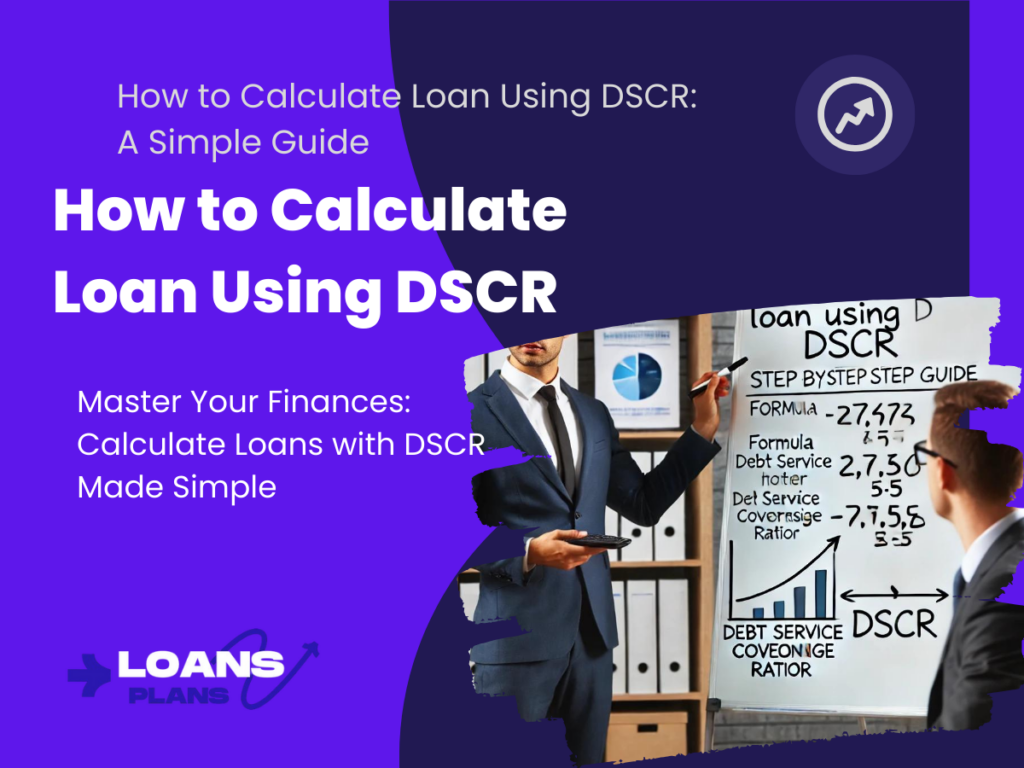To calculate a loan using DSCR (Debt Service Coverage Ratio):
- Determine annual net operating income
- Calculate total annual debt payments
- Divide net income by debt payments
- Aim for DSCR of 1.25 or higher
- Adjust loan amount to meet desired DSCR
Now we Explain in Detail:
How Do I Calculate Loan Using DSCR? A Comprehensive Guide to Debt Service Coverage Ratio
Have you ever wondered how lenders determine the maximum loan amount for commercial real estate or business loans? Well, let me introduce you to the magical world of DSCR – the Debt Service Coverage Ratio. It’s like a financial crystal ball that helps lenders predict if you’ll be able to repay your loan. But how do you calculate loan using DSCR? Don’t worry, I’ve got you covered. In this guide, we’ll dive deep into the DSCR calculation, explore its importance, and show you how to use it to your advantage. So, grab your calculator (or smartphone), and let’s crunch some numbers!
What is DSCR and Why Does It Matter?
Before we jump into the nitty-gritty of calculations, let’s break down what DSCR actually means. DSCR stands for Debt Service Coverage Ratio. It’s a financial metric that measures a company’s or property’s ability to cover its debt obligations using its operating income. In simpler terms, it tells you if you’re making enough money to pay your loans.
The DSCR Formula: Your Financial Lifeline
Here’s the basic DSCR formula:
DSCR = Net Operating Income (NOI) / Total Debt Service
Looks simple, right? But don’t be fooled – there’s a lot packed into those few words. Let’s break it down further:
- Net Operating Income (NOI): This is your total revenue minus operating expenses (but before taxes and interest payments).
- Total Debt Service: This includes all your loan payments, including principal and interest.
A DSCR of 1.0 means you’re just breaking even – your income exactly covers your debt payments. Most lenders prefer to see a DSCR of 1.25 or higher, which gives them a comfortable cushion.
How to Calculate Loan Using DSCR: A Step-by-Step Guide
Now that we’ve got the basics down, let’s walk through the process of calculating a loan using DSCR. We’ll use a real estate investment example to make things clearer.
Step 1: Calculate Your Net Operating Income (NOI)
First, you need to determine your NOI. Let’s say you’re looking at a small apartment building:
- Annual Rental Income: $200,000
- Vacancy and Credit Loss (5%): $10,000
- Operating Expenses: $70,000
NOI = $200,000 – $10,000 – $70,000 = $120,000
Step 2: Determine Your Target DSCR
Most lenders have a minimum DSCR requirement. Let’s assume the lender wants a DSCR of 1.25.
Step 3: Calculate Maximum Annual Debt Service
To find out how much debt you can take on, divide your NOI by the required DSCR:
Maximum Annual Debt Service = NOI / Required DSCR $120,000 / 1.25 = $96,000
This means you can afford annual loan payments of up to $96,000.
Step 4: Determine Loan Amount
Now, to calculate the actual loan amount, you’ll need to consider the interest rate and loan term. Let’s assume a 5% interest rate on a 25-year loan.
Using a loan calculator or amortization table, you can determine that annual payments of $96,000 at 5% interest over 25 years would allow for a loan of approximately $1,360,000.
Voila! You’ve just calculated a loan using DSCR.
The Art of DSCR: Factors That Influence Your Calculation

Calculating a loan using DSCR isn’t always as straightforward as our example. Several factors can influence your DSCR and, consequently, your loan amount:
1. Property Type and Location
Different property types and locations come with varying risk levels. A stable apartment building in a prime location might allow for a lower DSCR than a niche commercial property in a less desirable area.
2. Borrower Experience
Lenders often consider your track record. If you’re a seasoned investor with a portfolio of successful properties, you might get away with a lower DSCR compared to a first-time investor.
3. Market Conditions
Economic factors and real estate market trends can impact DSCR requirements. In uncertain times, lenders might require higher DSCRs as a safety net.
4. Loan Terms
The interest rate and loan term significantly affect your debt service and, therefore, your DSCR. A lower interest rate or longer term can improve your DSCR by reducing your annual payments.
DSCR Calculation: Best Practices and Common Pitfalls
To master the art of calculating loans using DSCR, keep these tips in mind:
- Be Conservative: When estimating income and expenses, it’s better to underestimate income and overestimate expenses. This gives you a safety margin.
- Consider Variability: If your income or expenses fluctuate seasonally, make sure your DSCR can handle the lean times.
- Factor in Reserves: Many lenders require cash reserves in addition to meeting DSCR requirements. Don’t forget to account for this.
- Look Beyond DSCR: While DSCR is crucial, it’s not the only factor lenders consider. Your credit score, liquidity, and overall financial health matter too.
- Plan for the Future: Consider how potential changes in the market, such as rising interest rates or shifts in rental demand, might affect your DSCR.
Advanced DSCR Calculations: Taking It to the Next Level
Ready to dive deeper? Let’s explore some advanced concepts in DSCR calculations.
Global DSCR: The Big Picture
If you’re a real estate mogul with multiple properties, lenders might look at your Global DSCR. This considers the total NOI from all your properties against your total debt service. It’s like a financial report card for your entire portfolio.
DSCR with Balloon Payments
Some loans have balloon payments – larger payments due at the end of the loan term. When calculating DSCR for these loans, lenders might use a hypothetical fully amortizing payment to ensure you can handle refinancing when the balloon comes due.
Stressed DSCR: Preparing for the Worst
Lenders sometimes calculate a “stressed” DSCR to see how your property would perform under less-than-ideal conditions. This might involve assuming higher vacancy rates or lower rents. It’s like a financial fire drill for your investment.
DSCR Calculation Tools: Your Digital Assistants
In this digital age, you don’t have to rely solely on your trusty calculator. Several online tools and software can help you calculate DSCR and estimate loan amounts:
- DSCR Calculators: Many financial websites offer free DSCR calculators. Just plug in your numbers and voila!
- Spreadsheet Templates: Excel and Google Sheets have pre-made templates for DSCR calculations. These are great for running multiple scenarios.
- Property Management Software: Some advanced property management tools include DSCR calculation features as part of their financial analysis suite.
- Mobile Apps: For calculations on the go, check out DSCR calculator apps available for smartphones.
Remember, while these tools are helpful, they’re no substitute for understanding the underlying principles of DSCR calculations.
Real-World Applications: DSCR in Action
Let’s look at how DSCR calculations play out in different scenarios:
Scenario 1: The Overachiever
Imagine you’re eyeing a small office building with an NOI of $500,000. The lender requires a DSCR of 1.25, and you’re offered a loan at 4% interest over 30 years.
Maximum Annual Debt Service = $500,000 / 1.25 = $400,000 Potential Loan Amount ≈ $6,900,000
In this case, your strong NOI allows for a substantial loan amount.
Scenario 2: The Fixer-Upper
Now, let’s say you’re looking at a distressed property with current NOI of just $100,000, but you believe you can increase it to $200,000 with some improvements. The lender still requires a 1.25 DSCR.
Current Maximum Annual Debt Service = $100,000 / 1.25 = $80,000 Potential Future Maximum Annual Debt Service = $200,000 / 1.25 = $160,000
This shows how improving a property’s performance can significantly increase your borrowing capacity.
The Future of DSCR: Trends and Predictions
As the financial world evolves, so does the use of DSCR in loan calculations. Here are some trends to watch:
- AI and Machine Learning: Advanced algorithms might soon analyze vast amounts of data to predict future NOI and refine DSCR calculations.
- Green Building Incentives: Some lenders are starting to offer more favorable DSCR terms for environmentally friendly properties.
- Alternative Income Streams: As properties diversify their income sources (think coworking spaces in apartment buildings), DSCR calculations may evolve to better capture these complex revenue models.
- Real-Time DSCR Monitoring: Technology might allow for continuous DSCR tracking, enabling lenders to offer more dynamic loan terms.
Read Also: DSCR Loan (Debt service coverage ratio) Explained: A Comprehensive Guide for Investors
Conclusion: Mastering the Art of DSCR Calculation
Calculating loans using DSCR is more than just crunching numbers – it’s about understanding the story those numbers tell about a property’s financial health. By mastering DSCR calculations, you’re not just preparing for a loan application; you’re gaining invaluable insight into the potential of your investments.
Remember, DSCR is a tool, not a crystal ball. It’s one piece of the larger puzzle of real estate investment and financing. Use it wisely, in conjunction with other financial metrics and your own market knowledge, and you’ll be well-equipped to make informed decisions about your property investments.
So, the next time someone asks, “How do I calculate loan using DSCR?”, you can confidently walk them through the process. Who knows? You might just be the financial wizard they’ve been looking for!
Frequently Asked Questions
How often should I recalculate my DSCR?
It’s a good practice to recalculate your DSCR annually, or whenever there are significant changes in your property’s income or expenses. This helps you stay on top of your financial health and anticipate any potential issues with loan covenants.
Can I use DSCR calculations for personal loans?
While DSCR is primarily used for commercial and investment property loans, the principle can be applied to personal finances. Instead of NOI, you’d use your personal income, and instead of property expenses, you’d use your living expenses. This can give you a good idea of your personal debt capacity.
What’s considered a good DSCR?
Generally, a DSCR of 1.25 or higher is considered good by most lenders. However, this can vary depending on the property type, location, and overall market conditions. Some lenders might accept a lower DSCR for very stable properties, while others might require a higher DSCR for riskier investments.
How does DSCR affect interest rates?
A higher DSCR often translates to lower interest rates, as it indicates lower risk for the lender. Conversely, if your DSCR is just barely meeting the minimum requirement, you might face higher interest rates to compensate for the perceived higher risk.
Can I improve my DSCR without increasing income?
Yes, you can improve your DSCR by reducing your operating expenses or restructuring your debt. This might involve finding more efficient ways to manage your property, refinancing to a lower interest rate, or extending your loan term to reduce monthly payments. Remember, the goal is to increase the spread between your NOI and your debt service.



